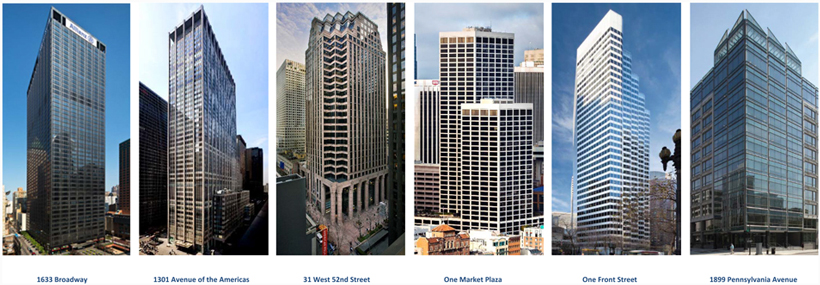| | |
 | | DEFINITIONS - CONTINUED |
Adjusted EBITDAre is a supplemental measure that is calculated by adjusting EBITDAre to eliminate the impact of the performance of our real estate funds, unrealized gains or losses on interest rate swaps, transaction related costs, gains or losses on early extinguishment of debt and certain other items that may vary from period to period. Adjusted EBITDAre enhances the comparability of EBITDAre across periods. In future periods, we may also exclude other items from Adjusted EBITDAre that we believe may help investors compare our results. We also presentPGRE’s share of Adjusted EBITDAre, which represents our share of Adjusted EBITDAre generated by our consolidated and unconsolidated joint ventures based on our percentage ownership in the underlying assets.
Net Operating Income (“NOI”)is used to measure the operating performance of our properties. NOI consists of rental revenue (which includes property rentals, tenant reimbursements and lease termination income) and certain other property-related revenue less operating expenses (which includes property-related expenses such as cleaning, security, repairs and maintenance, utilities, property administration and real estate taxes). We also presentCash NOI which deducts from NOI, straight-line rent adjustments and the amortization of above and below-market leases, including our share of such adjustments of unconsolidated joint ventures. In addition, we presentPGRE’s share of NOI and Cash NOI which represents our share of NOI and Cash NOI of consolidated and unconsolidated joint ventures, based on our percentage ownership in the underlying assets. We use NOI and Cash NOI internally as performance measures and believe they provide useful information to investors regarding our financial condition and results of operations because they reflect only those income and expense items that are incurred at property level.
Same Store NOI is used to measure the operating performance of properties that were owned by us in a similar manner during both the current period and prior reporting periods, and represents Same Store NOI from consolidated and unconsolidated joint ventures based on our percentage ownership in the underlying assets. Same Store NOI also excludes lease termination income, impairment of receivables arising from operating leases and certain other items that may vary from period to period. We also present Same Store Cash NOI, which excludes the effect of non-cash items such as the straight-line rent adjustments and the amortization of above and below-market leases.
PGRE’s Share of Total Debt represents our share of debt of consolidated and unconsolidated joint ventures, based on our percentage ownership in the underlying assets. We believe that PGRE’s share of total debt provides useful information to investors regarding our financial condition because it includes our share of debt from unconsolidated joint ventures and excludes the noncontrolling interests’ share of debt from consolidated joint ventures that is attributable to our partners.
Annualized Rent represents the end of period monthly base rent plus escalations in accordance with the lease terms, multiplied by 12.
Leased % represents percentage of square feet that is leased, including signed leases not yet commenced.
Same Store Leased % represents percentage of square feet that is leased, including signed leases not yet commenced, for properties that were owned by us in a similar manner during both the current period and prior reporting periods.
Occupied %represents the percentage of space for which we have commenced rental revenue in accordance with GAAP.
Initial Rent represents the weighted average cash basis starting rent per square foot and does not include free rent or periodic step-ups in rent.
Prior Escalated Rent represents the weighted average cash basis rent (including reimbursements) per square foot at expiration.
Second Generation Spacerepresents space leased that has been vacant for less than twelve months.
Capital Expenditures consist of expenditures to maintain assets, tenant improvement allowances and leasing commissions.Expenditures to Maintain Assets include capital expenditures to maintain current revenues.Second Generation Tenant Improvements and Leasing Commissions represent tenant improvements and leasing commissions incurred in leasing second generation space.First Generation Leasing Costs and Other Capital Expenditures include capital expenditures completed in the year of acquisition and the following two years that were planned at the time of acquisition, as well as tenant improvements and leasing commissions on space leased that has been vacant for more than twelve months.Development Expenditures consist of hard and soft costs related to the development of a property in getting it ready for its intended use.
- 44 -


